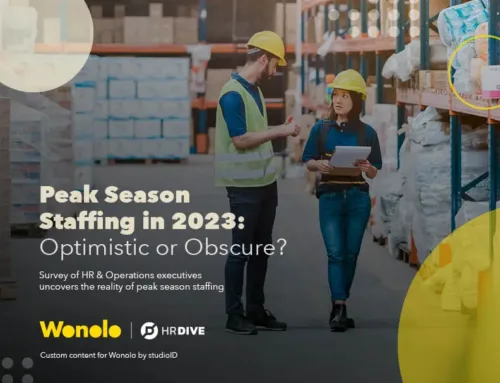Lori Macias
The 2020 holiday season was better than expected for retailers and 3PLs, due in large part to the COVID-19-induced surge in e-commerce sales.
In 2021, the holiday season promises to be even better, with retail sales projected to rise from seven to nine percent, according to estimates from Deloitte, as reported in Retail Dive.
According to a September 2021, RetailMeNot survey, shoppers are even more optimistic. They plan to spend 15% more on holiday shopping in 2021. Notably, this year, thanks to the COVID-19 vaccines and fewer social distancing regulations, shoppers are planning to purchase half of their gifts in brick-and-mortar stores, which is good news for retailers who took a hit during the 2020 holiday season.
But where are the workers? This is one of the top-of-mind challenges for retailers and 3PL companies.
Top Holiday 2021 Challenges for Retailers and 3PLs
There are two major challenges that could impact retailers’ and 3PLs’ success during the 2021 holiday season.
Supply Chain Issues
First, the global supply chain is broken, and retailers are having difficulty receiving components and finished goods. If they are unable to receive these goods, they can’t sell them, and warehouses and 3PLs can’t fulfill and ship them.
Supply chain issues began in 2020, when the COVID-19 pandemic forced factories around the world to close, which diminished the supply of some goods. While demand is bouncing back in the U.S., due to COVID-19 vaccines, lifted restrictions, and a boom in online shopping, manufacturers and other supply chain businesses in other parts of the globe are scrambling to keep up.
The biggest pain point is a shortage of truck drivers, port workers, and rail crew, according to Gary Hufbauer, a nonresident senior fellow with the Peterson Institute for Economics, a Washington think tank, as reported in the Austin American-Statesman.
A host of other issues is contributing to supply chain woes. First, COVID-19 restrictions for factories in Asia are delaying the production of products, as well as transportation and logistics, which also raises prices. There are not enough shipping containers. Ports are backed up. An ongoing problem is the continued underinvestment in infrastructure, which will be addressed (over time), by the federal infrastructure bill.
In a last-minute “Hail Mary” move to help retailers and 3PL companies during the 2021 holiday season, on October 13, the Biden administration announced a “90-day sprint” to lessen bottlenecks of ports. This includes an action facilitated by President Joe Biden, in which the Port of Los Angeles will move to 24/7 service, in concert with the Port of Long Beach, which is already on a 24/7 schedule. The two ports alone handle 40% of the U.S. container traffic.
The President also announced that major retailers and 3PLs, including Walmart, Target, Home Depot, FedEx, and UPS, have committed to increasing the number of goods they ship at night.
While the administration’s 90-day sprint will not solve all of the supply chain problems, it may provide some relief to retailers and 3PLs during the critical 2021 holiday season.
Labor Shortage and Competition for TemporaryWorkers
Despite the supply chain issue, retailers and 3PLs are planning for a robust holiday season, with a strong need for temporary workers.
That is the second problem. There is a massive shortage of labor, and it was present even before the holiday season.
Retail Dive reported that retail store job openings, including those for cashiers, salespeople, and customer service representatives, reached 1.2 million in July 2021, up from 876,000 last year, according to the Bureau of Labor Statistics. Retailers also need to fill more than 400,000 warehousing jobs in 2021, according to Supply Chain Dive.
In the logistics industry, job openings are at a 20-year high, with 533,600 openings, according to Inbound Logistics. Data from the The Third-Party Logistics Warehouse Benchmark Report, as reported in Yahoo! Finance, showed that 48% of 3PLs are having a difficult time finding and retaining qualified workers.
Labor shortages are also contributing to operational difficulties and increasing costs. FedEx is one example. Over 600,000 packages a day in its Ground network need to be rerouted due to staffing shortages. In addition, FedEx has only 65% of the workers it needs to handle regular volumes at its hub in Portland, Oregon. The increase in shipping activity during the holidays will only make this issue worse.
Retailers and 3PL companies are facing stiff competition for temporary workers from some of the largest companies in their industry. Here are some examples of the number of workers companies will be adding during the 2021 holiday season:
In addition, retailers and 3PL companies will be competing for workers with the hospitality industry, which is experiencing a surge in 2021 holiday bookings, and also has a labor shortage.
Businesses in all of these industries were hopeful that more workers would be interested in seasonal work after September 6. On that day, the federal aid program that provided unemployment benefits for workers ended.
Yet with the ending of pandemic relief funds, there has not been a major increase in interest for work. The reasons are unclear. Some economists suggest that ongoing COVID-19 health concerns and caregiving responsibilities may be a factor. The result from a recent survey of 3,000 Wonoloers (workers using the Wonolo platform to find short-term job opportunities from third-party businesses) suggests that workers may be more selective when looking for jobs, expecting better pay, benefits and flexibility:
- 40% are thinking about quitting their jobs
- 74% want higher wages
- 63% want flexibility
How Your Company Can Attract Temporary Workers This Holiday Season
Temporary workers can help alleviate the burden of a demand spike on your business all while allowing your full-time employees to focus on the duties central to their jobs. Temporary workers can also be more cost-effective than hiring a new team of full-time employees to handle seasonal demands.
However, labor shortages and competition for workers means that retailers and 3PLs may have to be flexible and creative to attract holiday workers.
Consider borrowing some of these ideas from national and local companies.
Increasing Pay – Through Higher Hourly Wages and Bonuses
Amazon announced it would be offering seasonal workers an average starting pay of $18 per hour, sign-on bonuses of up to $3,000 and a possible additional $3 per hour depending on the location and shift.
Kohl’s will be offering bonuses of up to $400 for seasonal employees who stay through the entire holiday season.
On top of its $15 minimum wage, Target announced a $2 per hour increase for workers during certain peak periods from October to December, 2021. These include certain Saturdays and Sundays for store and service employees and peak two-week periods between October 10 and December 18 for supply chain team members.
FedEx announced that it will be offering pay increases in certain locations, and UPS, according to an MSN report, starts workers at $15 per hour.
More Flexibility
The pandemic opened up a world of possibilities for workers, including the prospect of more flexibility. This season, with the power of a severe labor shortage to back them up, workers have pushed back on weekend, late night, and holiday shifts that are common for seasonal work in the retail and 3PL industries. Some companies in the industry have opted to be more flexible to attract these workers.
Balsam Hill, which sells high-end artificial holiday trees, had difficulty staffing its outlet store in Dallas. It finally opened on September 1, 2021, but was forced to close after four of its five workers quit, after deciding they didn’t want to work weekends, as reported in the Associated Press. Weeks later it had nine workers, after increasing its pay to $18 from $15, and offering individual schedules based on when they want to work. One example is a retired pastor who still preaches on Sunday, and didn’t want to work on that day. Balsam Hill agreed to his request.
Larger companies are also offering this type of perk. For example, Belk wants to hire 5,000 seasonal workers, and is offering flexible schedules, in addition to competitive pay and discounts, according to Retail Dive. Target offers workers the ability to be in control of their schedules, by allowing them to add or swap shifts through its new mobile app.
Discounts
Retailers can also attract workers by helping them save money by offering a discount on goods and services.
Belk announced that it would offer seasonal workers a 20% discount and special holiday double-discount days. Target offers a 10% discount to seasonal workers. If you’re a retailer, offering a discount to seasonal or temporary workers could be a smart way to attract workers.
More Ideas
In addition to higher wages, increased flexibility, and discounts, think about what might attract workers to your business and lead them to spread the word about how great it is to work for your business.
Consider offering referral incentives to workers bringing in their friends to the seasonal fold. Not only will they enjoy the monetary bump, but studies show that those who have friends at work are more likely to be happier and more productive. While those studies focused on employees, it still makes sense for temporary workers. After all, we’d rather work with people we like to be around.
Provide ongoing communication and recognition. Yes, even temporary workers want to know what’s going on in the business and want to be recognized for doing a good job. Let them know when you had a record-breaking sales day, and thank them for their contribution. Both positive feedback and constructive criticism are valued by workers — especially Millennial and Gen Z team members.
Take an interest in your temporary workers, and check-in with each of them. Your conversations may be different depending on what’s happening in their lives. A Boomer, for example, may be excited about holiday visits with grandchildren. A Gen Xer may be hosting a big holiday dinner. A Millennial may be planning a trip. A Gen Zer might be in college, and concerned about final exams and the latest football game.
Get Help
Keep in mind, if your business has short-term jobs that can be performed by contingent workers this season, Wonolo’s online job marketplace can be a game-changing resource to explore. Depending on your business needs, the Wonolo platform enables you to connect to experienced workers in your area that are available to work immediately, helping ensure that you have a successful holiday season.


![[Report] Beyond the Gig: Exploring Reliable Work Options for the Modern Workforce](https://info.wonolo.com/wp-content/uploads/2023/10/Worker-Preferences-Report-Header-Image-500x383.png)



